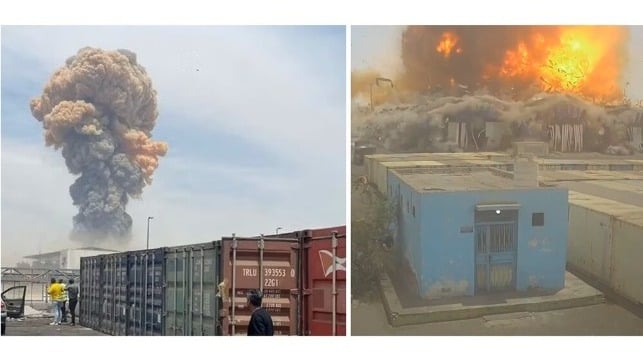After Blast, Fires Burn Through Iran's Main Container Terminal

Fires caused by the huge explosion in the commercial port of Bandar Abbas in Iran on the morning of April 26 were still spreading two days later. Heat and fire detected by the NASA FIRMS system on the morning of April 29 still showed no signs of any retreat, with the area affected now having spread from the container park to the quays of the port itself.
Social media videos of the scene on April 28 make it clear that the firefighting services have been overwhelmed, even though reinforcements have been brought in from as far away as Tehran; two days after the initial explosion, some areas of the fire were not being tackled at all, and in other areas confused port workers who should have been evacuated were still wandering around or sheltering in empty containers in what was clearly still a dangerous area.
Des avions de secours russes ont aidé à combattre l'incendie du port de Shahid Rajaï après l'explosion de Bandar Abbas pic.twitter.com/jOvjkYa7P2
— Magazine militaire iranien (@iranmilitary_FR) April 29, 2025
Russian firefighting aircraft drop water on still-burning areas of the port (Iranian social media)
#FreeIran2025 : Bandar Abbas — #Iran pic.twitter.com/K5zNKnc6aR
— sheer_iran (@sheriran95) April 29, 2025
Officials examine the wreckage from the blast (Iranian social media)
A spokesman for Iran’s crisis management organization said it could take 20 days to fully extinguish the fire. The latest casualty count puts the number of fatalities at over 70, and a large number of the injured are suffering from the effects of the massive blast pressure wave.
There is an active debate in Iran’s media as to who is responsible for the disaster. Conservatives, dominant in the Iranian parliament and supporters of the Supreme Leader, have blamed breaches of safety regulations in the container park, seeking to avoid accusations that the security apparatus failed - notwithstanding media coverage of the sodium perchlorate consignment on its passage from China and its arrival in Bandar Abbas.
Reformists have been forthright in casting the incident as sabotage, implying that Israel mounted the attack, but have also highlighted the expenditure of Iranian resources put into the nation’s missile program at the cost of investment in the civil economy. So far, the reformist arguments appear to be winning the day.
It is noticeable that while the reformist President Masoud Pezeshkian has visited the injured in hospital, no senior clerical leader has yet visited the scene. This may be for fear of being associated with the consequences of the Supreme Leadership’s confrontational program of regional expansionism; this policy push has not only attracted sanctions but also drawn resources away from productive areas of the economy, which are desperately short of investment.
Although the port authorities have claimed that there has been some return to operations, the extent of the damage both to the port itself - and to the supporting infrastructure such as railways and customs clearance areas – means that throughput will be severely reduced for months. Bandar Abbas handles about 80% of Iran’s imports and exports, and until it is restored, the much smaller container terminal in Bushehr will have to absorb the diverted traffic. This is at a time when Iran’s precarious economy is in dire straits, and can ill afford further upsets.
The political fallout and economic consequences of the disaster will fuel an already-high level of popular discontent. Supreme Leader Ali Khamenei - and the Islamic Revolutionary Guard Corps, which exists to keep the clerical leadership in power - are acutely aware of the depth of feeling. An incident of this nature provides an escape valve for reformists, providing a pretext for airing dissent that the authorities are normally able to suppress.
Israel still denies involvement in the explosion, but the timing of the blast may align with Israeli foreign policy interests, as it coincides with the latest round of US-Iranian nuclear negotiations in Muscat.
Reports suggest that Iran has rejected any chance of cutting its missile program within the scope of the nuclear negotiations, and this sticking point has been a key element of the talks. On this issue, there may be a difference of opinion between US and Israeli political leaders. Given Israel’s experience under fire during Operations True Promise 1 and 2, the vast nature of Iran’s well-protected missile and drone arsenal, and Iranian threats of an Operation True Promise 3, Israel may have much greater existential concerns over its vulnerability to the missile threat than is appreciated by the United States. U.S. negotiators have a different set of incentives, and may be tempted to compromise on Iran’s missile program so as to secure a rapid political win.
If Israel were behind the blast, it would be a message to the United States - as well as to Tehran - that the neutralization of the Iranian missile threat is a requirement for Israeli foreign policy. It would also send a message as to what Israel might further be prepared to do, with or without US approval.
The opinions expressed herein are the author's and not necessarily those of The Maritime Executive.
